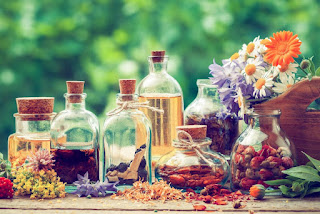Herbal Tinctures and Extracts: A Guide to Making Your Own Natural Remedies
In a world where natural remedies are gaining popularity, herbal tinctures and extracts have emerged as powerful tools for promoting health and well-being.Harnessing the medicinal properties of plants, these homemade concoctions offer a plethora of benefits, making them a popular choice for both traditional and modern herbalists.
If you're curious about exploring the wonders of herbal medicine and creating your own tinctures and extracts, this guide will equip you with the knowledge and confidence to embark on this rewarding journey.
Section 1: Understanding Herbal Tinctures and Extracts
Herbal tinctures and extracts are concentrated liquid forms of medicinal herbs, obtained by using alcohol, glycerin, or vinegar as a solvent to extract the plant's beneficial compounds.
While both tinctures and extracts are potent herbal preparations, they differ in the concentration of the herb's active constituents. Tinctures typically use alcohol as the solvent and have a higher concentration of the herb, making them more potent.
On the other hand, extracts may use glycerin or vinegar as a solvent and usually have a milder potency.
The allure of tinctures and extracts lies in their efficiency and long shelf life. When stored properly, they can retain their potency for several years, providing a readily available and convenient herbal remedy.
Section 2: Choosing the Right Herbs
Selecting high-quality herbs is the foundation of making effective tinctures and extracts.It's crucial to source herbs from reputable suppliers or grow them organically to ensure their purity and potency.
Each herb possesses unique medicinal properties, so understanding their specific uses is essential in crafting effective herbal remedies.
For beginners, certain herbs are ideal for tincture-making due to their ease of use and wide range of benefits.
Popular beginner-friendly herbs include chamomile for relaxation, calendula for skin health, and lemon balm for stress relief.
Experimenting with these versatile herbs can be a great starting point for those new to herbal medicine.
Section 3: Equipment and Supplies Needed
Creating tinctures and extracts requires minimal equipment, making it accessible to most aspiring herbalists. The primary tools you'll need include glass jars or bottles, a kitchen scale, a funnel, and a label for each preparation.
To ensure safety and effectiveness, it's essential to clean and sterilize the equipment thoroughly before use.
For those on a budget, several alternatives exist for making herbal preparations. Repurposed glass jars, kitchen measuring tools, and basic labels can serve as cost-effective options without compromising the quality of the final product.
Section 4: The Tincture-Making Process
Making herbal tinctures is a simple yet precise process that involves extracting the herb's medicinal compounds using alcohol as the solvent.Here's a step-by-step guide:
1. Measure the Herb: Weigh the dried herb using a kitchen scale to ensure accurate measurements.
2. Choose the Menstruum: Select the appropriate alcohol strength based on the herb's properties. For most tinctures, a 40-60% alcohol concentration is suitable.
3. Combine the Herb and Alcohol: Place the measured herb in a glass jar and cover it with the chosen alcohol. Ensure the herb is fully submerged.
4. Label and Date: Label the jar with the herb's name, alcohol percentage, and the date of preparation. This will help you keep track of each tincture's unique properties and shelf life.
5. Shake and Infuse: Seal the jar tightly and shake it gently. Allow the mixture to infuse for at least 4-6 weeks, storing it in a cool, dark place. Shake the jar daily to aid the extraction process.
6. Strain and Bottle: After the infusion period, strain the tincture through a fine mesh strainer or cheesecloth. Transfer the liquid into dark glass bottles, and label them appropriately.
Herbal tinctures: 6 types and recipes
Section 5: Extract-Making Techniques
Apart from tinctures, other extraction techniques like decoctions, infusions, and maceration can be employed to create herbal extracts:
Decoctions: Decoctions are made by boiling the herb's roots, bark, or seeds in water. This method is ideal for extracting compounds that are not easily soluble in alcohol or glycerin.
Infusions: Infusions involve steeping the herb's leaves, flowers, or soft parts in hot water. This is a common method for creating herbal teas and is particularly effective for delicate herbs.
Maceration: Maceration is similar to making tinctures but uses glycerin or vinegar as the solvent instead of alcohol. This makes maceration a non-alcoholic option suitable for children or those avoiding alcohol.
Section 6: Proper Storage and Usage
To ensure the longevity and potency of your herbal tinctures and extracts, proper storage is crucial.Remember to label each preparation clearly, noting the herb's name, alcohol concentration (if applicable), and preparation date.
When using tinctures and extracts, it's essential to follow recommended dosages to avoid adverse effects. Begin with small doses and gradually increase if necessary.
If you're unsure about dosage or potential interactions with medications or medical conditions, consult a qualified herbalist or healthcare professional.
Conclusion:
Making herbal tinctures and extracts is a fulfilling and empowering journey that allows you to connect with the healing power of nature.
Understanding the distinctions between tinctures and extracts, selecting the right herbs, and mastering the preparation techniques will equip you with the skills to create effective and personalized herbal remedies.
Embrace the art of herbal medicine and savor the joys of crafting your own natural remedies for a healthier and more balanced life. Remember to approach this practice with curiosity and respect for the potent gifts that nature provides. Happy herbal crafting!












